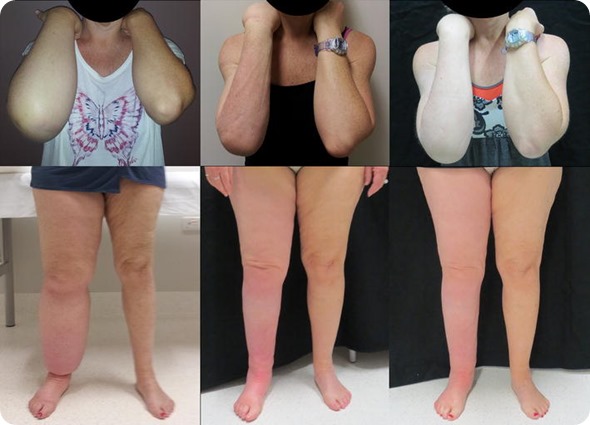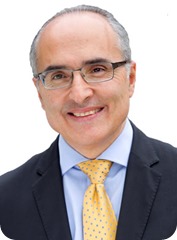What is lymphedema and why does it sometimes occur following breast cancer treatment?
Lymphedema is persistent swelling of the arm and/or hand following biopsy or treatment of the axillary lymph nodes for patients with breast cancer. It is due to excess accumulation of protein‐rich fluid in body tissues.

First arm and leg liposuction patients, both right-side affected.Left panel pre-liposuction, middle panel 6 months post-liposuction, right panel 12 months post-liposuction.
© Springer / John Boyages, under Creative Commons Attribution License, retrieved from: http://link.springer.com/article/10.1245/s10434-015-4700-3
Patients who have all lymph nodes removed in the axilla during cancer treatment have, on average, a 20% chance of developing lymphedema. This risk is increased to over 50% when the axilla is treated by surgery and radiation.
If a sentinel node biopsy is performed, the risk is reduced to about 5‐8%. It presents as swelling of the fingers, back of the hand and the arm. It can be associated with heaviness, tightness, tingling, and often recurrent bouts of infection (cellulitis).
What impact does lymphedema have on the physical and emotional health of cancer survivors?
Lymphedema can be a daily reminder of previous cancer treatment. It can have a significant impact on physical, functional and psychological domains, as well as social life, family, work and finances and often leads to social isolation. In some cases, it can lead to loss of employment, as a heavy arm or leg means affected patients cannot work.
A recent study we conducted of 361 breast cancer survivors found that both breast cancer and lymphedema had a significant negative impact on women’s work and career and impacted 43% of working women.
The additional burden of lymphedema and days off work was incrementally worse as the severity of the condition increased. The annual number of days off work for subclinical/mild Lymphedema participants was 1.4 days versus 8.1 days for moderate or severe participants.
What methods are currently used to detect lymphedema, prevent progression and reduce swelling?
Lymphedema can be detected early with a bioimpedance device called L‐Dex® that measures the presence of extracellular fluid even before a symptom occurs.
The Macquarie University Lymphedema Program is currently enrolling patients in an international multicentre early detection study conducted by Vanderbilt University, randomising patients between L‐Dex® and conventional tape‐measure girth measures, with early intervention using a compression garment if sub‐clinical lymphedema is detected. This approach may prevent progression to advanced lymphedema which does not respond to treatment.
What prompted you to investigate liposuction for the management of lymphedema?
I was lobbied very hard to offer this treatment at Macquarie University by our Lymphedema rehabilitation specialist, Dr Helen Mackie. At first, I thought she had “rocks in her head”, as we were advising patients not even to have blood taken from their affected arm after lymphedema.
The more I investigated the procedure, introduced by Dr Hakan Brorson in Malmo, Sweden over 20 years ago, the more I realised this could indeed be an effective treatment method.
Professor Alex Munoch, a plastic surgeon trained by Brorson, and accredited to do the procedure in the UK, came to Australia to help us do our first case in April 2012. We have now done over 60 cases with excellent results.
How does liposuction work?
Once lymphatic fluid spills into the surrounding tissues it causes inflammation, stimulating fat stem cells to grow. Our MRI studies have shown that for many patients with advanced Lymphedema, there is very little fluid, but a lot of fat deposition. Once this occurs, it’s too late for compression garments to work effectively and the only treatment is medical liposuction.
This procedure removes the fat from the affected limb to match its size to the other, unaffected limb. The liposuction procedure is performed via multiple small incisions in the limb under general anaesthesia following limb exsanguination through application of a tourniquet.
A specialised cannula is used to remove subcutaneous tissue from the multiple small incision sites along the limb. Compression garments or Ready Wraps are applied to the affected limb immediately after surgery and are continuously worn 24 hours per day.
Can you please give a brief overview of your research methods? What were your main findings?
We have been comparing the type of fat in a fatty leg due to lymphedema and comparing it to normal fat that is removed during cosmetic liposuction. We have been working on how to quantify the relative proportions of fat, fluid, muscle and bone in pre‐ and post‐liposuction MRIs.
Our initial results are published here. We found significant improvements in physical, functional and psychological outcomes in all patients, with the affected limb reduced to the same size as the unaffected limb in the majority of patients by twelve months post‐surgery.
What impact do you think this research will have on patients with advanced lymphedema moving forwards?
The most amazing thing is that this treatment can change a patient’s total outlook on life. After surgery, patients can wear clothes that they weren’t able to wear for a long time; they can wear shoes or boots if a leg is treated and can start exercising again.
One of our patients has begun running again and lost over 20 kg in weight after her liposuction. She climbed the Sydney Harbour Bridge 3 months after liposuction as shown here in a video message to Prof Hakan Brorson, who assisted us in the procedure.
What factors need to be considered when determining the economic value of liposuction for advanced lymphedema?
Liposuction is often criticised as a procedure because the patient still needs to wear a compression sleeve afterwards. However, as an arm may weigh up to 2kg less, or a leg up to 12kg less after the surgery, this makes a significant difference to function, productivity and self‐esteem. Further, the number of episodes of cellulitis requiring admission can fall dramatically, reducing time off work and health costs.
In our National survey mentioned above, the incidence of cellulitis was 7.7% in 91 patients with subclinical or mild lymphedema compared to 29.5% of 61 patients with moderate to severe lymphedema. In Australia, the surgery is currently offered only at Macquarie University to self‐insured and privately insured patients, with out‐of‐pocket costs from A$8,000.
Where can readers find more information?
http://muh.org.au/Services‐Specialties/Lymphedema‐Program
More information about surgical options for Lymphedema from the International Lymphedema Framework can be found here.
Liposuction for Advanced Lymphedema A Multidisciplinary Approach for Complete Reduction of Arm and Leg Swelling, Springer, Annals of Surgical Oncology: http://link.springer.com/article/10.1245/s10434-015-4700-3
About Professor John Boyages 
John is a cancer specialist with over 30 years’ experience in the diagnosis and treatment of breast cancer. After graduating from the University of Sydney, he trained at Westmead Hospital and at the Dana Farber Cancer Institute at Harvard in Boston.
John is a radiation oncologist at Macquarie University Hospital and the author of several “Taking Control” books including his recent publication on Male Breast Cancer (www.bcpublish.com). He has published more than 140 research papers and provides consultations to patients from all over Australia and the Asia‐Pacific.
John was appointed to Macquarie University in 2011 as the Director of the Cancer Program and helped establish many clinical, research and patient support programs related to cancer. He is now the Director of the Lymphedema Program and Professor of Breast Oncology at the Faculty of Medicine and Health Sciences.